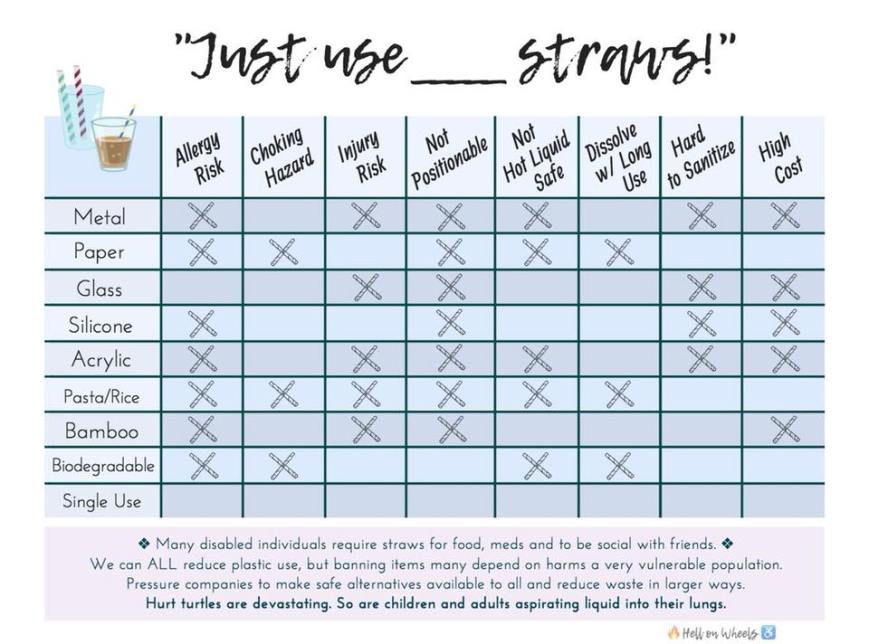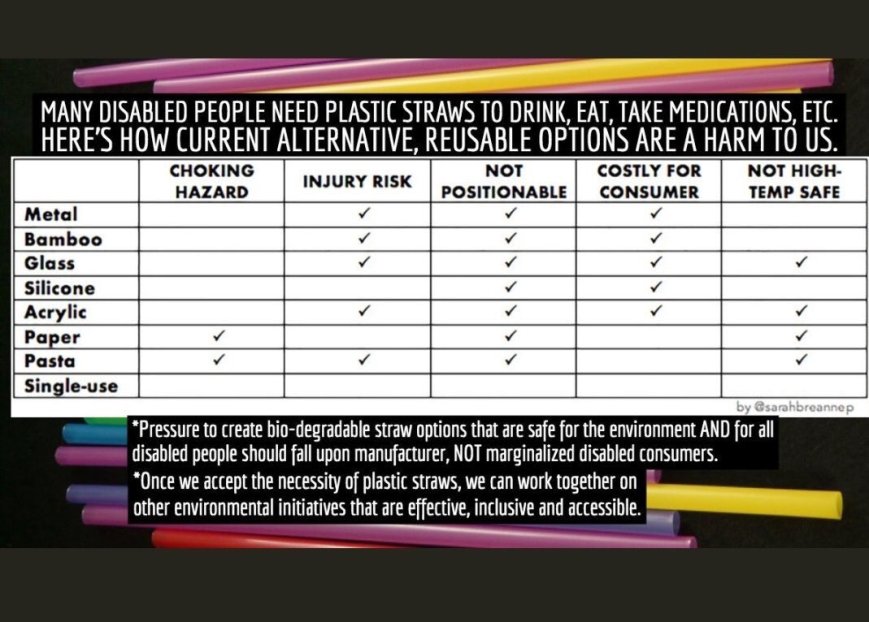For the past few months, an increasing number of cities and states either have passed bans against single-use plastic straws or are thinking about it. And in the rush to push through these straw bans, decision makers have not spent nearly enough time listening to disabled people explaining how poorly considered or poorly designed laws could threaten their ability to hydrate out of their home. And people trying to argue that disabled people “should just use” one of the alternate types of straws don’t have all the facts either.
Fortunately, various people with great visual design skills have developed great that summarize some (not all) of the key concerns that people with disabilities have about alternate straw solutions. I provide the three I am aware of on this page for easy access (see below)
These infographics are not mine. I’m just passing them along. If anyone knows the name of the creators so I can give due credit, please let me know.
I have added an alt tag for each image. Alt tags are designed so that people can read them only if they are listening to a web page via screen reading software, or otherwise accessing the web with the images turned off. Alt tags are normally invisible (hidden) for sighted people viewing the images. But unfortunately alt tags cannot be transferred with the picture from one website to another (or from, say, a website to Facebook or Twitter or vice versa). Which means we have to insert the text into the alt tag field each and every time we post it somewhere, even if it already had an alt tag in the original source! I know many of you will want to make these images accessible for people who are blind or have other print disabilities. I am therefore providing the same image description below each infographic on this page so you can copy/paste as needed when circulating these images. Feel free to revise the descriptions if you can improve them, as long as you remain dedicated to clarity and accuracy.
In some contexts (for example, in Twitter) too little space may be allowed for the full image description. Even the description field for the images you add to your Tweet is still much too short! In these cases you may wish to link to this page so people can read the full description here. Or copy/paste the text to your own website if you prefer.

No, none of these infographics is mine. This one is by Hell On Wheels (Twitter handle @rollwthepunches). The creator is going to DM me a high-quality image that will soon replace this one, so come back here to check.
I cannot take credit for this description either. I am using a description written by Cole Jurceka in response to this Facebook post Only the final line (noting the signature by Hell on Wheels) is mine:
“This is an image of a spreadsheet chart entitled “Just use blank fill in the word space straws.” Along the left side there is column listing materials straws may be made out of. Across the top row are columns titled each with a barrier or problem. Each category of straw material has an x in the column of barrier depending on which barrier is relevant to that material. Metal straws have allergy risk, injury risk, not positionable, not hot liquid safe, hard to sanitize, and high cost marked as barriers. Paper straws have allergy risk, chocking hazard, not positionable, not hot liquid safe, and dissolve with long use marked as barriers. Glass straws have injury risk, not positionable, hard to sanitize, and high cost marked as barriers. Silicone straws have allergy risk, not positionable, hard to sanitize, and high cost marked as barriers. Acrylic straws have allergy risk, injury risk, not positionable, not hot liquid safe, hard to sanitize, and high cost marked as barriers. Pasta or rice straws have allergy risk, chocking hazard, injury risk, not positionable, not hot liquid safe, and dissolve with long use marked as barriers. Bamboo straws have allergy risk, injury risk, not positionable, and high cost marked as barriers. Biodegradable straws have allergy risk, choking hazard, not hot liquid safe, and dissolve with long use marked as barriers. Single use straws are have no barriers marked. Undearneath the chart is a text that reads “Many disabled individuals require straws for foods, meds, and to be social with friends. We can ALL reduce plastic use, but banning items many depend on harms a very vulnerable population. Pressure companies to make safe alternatives available to all and reduce waste in larger ways. Hurt turtles are devastating. So are children and adults aspirating liquid into their lungs.” At the very bottom it is signed by “Hell on Wheels” with a burning yellow flame in front and the blue icon of a wheelchair stick figure at the end.”

This infographic is by Sarah Packwood, here is the link to her first use of this infographic in May 2018, complete with image description in her tweet thread!
Alice Wong The 2nd one is by Sarah Packwood and if you want to include the original link in your post https://twitter.com/sarahbreannep/status/998632056241307649
“The background shows plastic drinking straws in different colors. The main image on the background is a chart. The text above the chart says, “Many disabled plastic people need plastic straws to drink, eat, take medications, etc. Here’s how current alternative, reusable options are a harm to us.” The left side column lists the options: Metal, Bamboo, Glass, Silicone, Acrylic, Paper, Pasta, Single-use. The top row lists the possible harms: Choking hazard, Injury risk, Not positionable, Costly for consumer, Not high-temp safe. For metal, the columns for injury risk, not positionable, and costly for consumer are marked with a check. For Bamboo, the same three columns are marked. For Glass, almost all columns (except choking hazard) are marked. For Silicone, the columns for not Positionable and Costly for consumer are marked. For acrylic, almost all columns (except choking hazard) are marked. For paper, the columns for choking hazard, not positionable, and not high-temp safe are marked. For Pasta, almost all columns (except “costly for consumer”) are marked. None of the columns are marked for “single-use”. Below the chart are these two bullet points: “*Pressure to create bio-degradable straw options that are safe for the environment AND for all disabled people should fall upon manufacturer, NOT marginalized disabled consumers. *Once we accept the necessity of plastic straws, we can work together on other environmental initiatives that are effective, inclusive and accessible.”

Again, I have provided an alt tag to describe this second infographic. But for people who wish to copy/paste the same description for your use in circulating the infographic, here goes:
“This infographic shows a drawing of a pink/purple narwhal, a bendy straw, three question marks, and an image of the globe. The text says, “How do plastic straw bans hurt disabled people? Many disabled people need plastic straws to eat and drink. It provides access and they are literally keeping some of us alive! We don’t hate the earth, but we really like being alive and able to access our communities!” This text is followed by bullet points saying,
- Paper and biodegradable straws break down faster than many of us can use them.
- Metal straws can cause injury if they are too hot or cold and also if the person has a disability that affects movement and motor skills.
- Reusable straws are great if you have the ability to wash, store and bring them with you every time you leave your house. Many disabled people do not.
- If you don’t need a plastic straw, then don’t use one, but you don’t need to hurt disabled people to show that you love the earth.
- Punishing disabled people who need plastic straws to live will have very little impact on the environment but looking into creating a more viable and ACCESSIBLE alternative to single use plastic and placing greater regulations on businesses that are polluting the earth on a much larger, much more dangerous scale sure would!
At the bottom of the infographic is the web link (not clickable in the infographic) for neurodiversitylibrary.org”How Poorly Considered Straw Bans Hurt Disabled People
Well, Okay, BUT …
So you think you have a reason to disagree with some of these infographics, or a question about some of the nuances. I can’t promise the answer to your question is here, but I’ll tackle some common ones.
- But it’s only $8! — This price may seem cheap to you. But disabled people are at high risk of poverty. Not all of us (many of us work and have economic privilege, including me), but a high ratio. For someone who is poor, yes $8 is a heck of a lot of money.
- It only takes me 2 minutes to wash this re-usable straw! – It may be easy and fast for you. But depending on the exact disability, it may take much longer for some disabled people–if it’s feasible at all. And, actually, NO, not all disabled people have a free personal care assistant to clean it for them.
- Just have your carer clean it for you! — Are you offering to pay to hire the carer? Because many people with disabilities already have a lot of difficulty getting anywhere near the number of hours of assistance they actually need in a typical week.
- Just carry it with you everywhere! – Some disabled people already do this. But some have cognitive issues that makes it difficult to track all the many things they already have to bring with them everywhere. And even for the best organized people who always have everything they need, things happen. Things get lost, or stolen, or suddenly ruined due to circumstances beyond control. People shouldn’t have to be denied access to hydration because of this. Also, it’s an issue of fairness. Non-disabled people can usually access hydration with minimal fuss or nuisance almost anywhere they go. Why shouldn’t disabled people expect the same?
- Here’s a great essay by Alice Wong with more thoughts on this issue, entitled “The Last Straw: I need plastic straws. Banning them puts a serious burden on people with disabilities.”
- If you’re still looking to learn more answers, go watch this great video by Jessica Kellgren-Fozard (yes, with human-edited captions), entitled “Banning Straws Huts People // The Last Straw” (August 3, 2018)
- Another great video by Jessica Kellgren-Fozard, entitled “What’s Wrong with Reusable Straws” (August 16, 2019) (Yes a whole year later, because many disabled people have been explaining these issues extensively, and over and over, for quite a while now. If you haven’t heard them, then you aren’t following enough disabled writers in social media, blogs, the news, etc. and should please try to do better, thanks.)
- Still need more? Find tons more web links, articles, etc., in the companion post to this one, Info & Resources for #StrawBan #SuckItAbleism Advocates.
Pingback: Info & Resources for #StrawBan #SuckItAbleism Advocates | Rambling Justice
Pingback: Infographics for #StrawBan #SuckItAbleism Advocates – Undecided Title
This is a great post about the infographics. I must say that in infographics such a powerful technique. Thanks for updating us.
Pingback: #SuckItAbleism / On Not Going Plastic-Free | Polly Atkin
Pingback: Hvorfor vi fremdeles trenger plastikksugerør | Beates rasteplass
Pingback: ableism is invisible if you are able – be the future